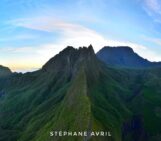
This blog post is part of our series: “Highlights” for which we’re accepting contributions! Please contact Emma Lodes (GM blog editor, elodes@asu.edu), if you’d like to contribute on this topic or others.
Interview with Richard Ott, Assistant Professor, University of Amsterdam. Email: r.f.ott@uva.nl, personal website: https://richardott.weebly.com/
Questions by Emma Lodes.
We’re continuing our mini series on islands with an interview with Richard Ott on his work on Crete! This gorgeous holiday destination is far more tectonically active than most realize, and hosts a carbonate landscape that Richard has studied to understand the impact of climate and tectonics on carbonate landscape evolution, among other projects. In this interview, Richard not only gives us more reasons to visit Crete, but also convinces us that carbonate landscapes are fascinating, understudied, and can teach us much about the impact of climate on landscape evolution!
What is special about the geomorphology of Crete?
If you measure from the seafloor, Crete may host the largest topographic gradient on Earth—rising from about –4 km to +2.5 km within just 50 km! Much of this dramatic relief is due to resistant carbonate rocks that have been uplifted in the footwalls of massive normal faults. These fault systems have raised parts of Crete by up to 9 meters in just the last 2000 years. It’s an impressively active place!
What was the main objective of your research there?
I’ve worked on several projects in Crete, from using surface deformation to understand subduction zone tectonics to studying how humans have changed erosion and sediment transport over millennia. But for this blog, I’ll focus on how carbonate landscapes evolve compared to the more common silicic landscapes that dominate most of the world.

Aerial imagery from NASA showing the difference in topography of clastic metamorphic rocks and carbonates despite similar uplift rate.
Why is Crete a good place to do this work?
Although large parts of Crete are made of felsic metamorphic rocks with mountains around 1000 m high, all three of the island’s >2000 m mountain ranges are in carbonate rocks. This happens despite similar uplift rates and erosion rates.
Why? My research suggests it’s linked to differences in erosional efficiency: in carbonates, much of the surface water disappears into underground drainage systems before it can erode the surface. As a result, streams must be steeper to keep pace. Additionally, groundwater capturing divides the landscape into a few deeply incised gorges and plateaus that lose all their runoff and erosional power. Because water doesn’t necessarily follow surface gradients, carbonate terrains produce all kinds of “weird” landscapes—ones that current landscape evolution models struggle to capture.
What was the best aspect or moment of doing field work there?
Fieldwork in Crete is simply amazing—the food, the landscapes, and the people. Because I mapped many marine terraces, I spent plenty of time on beautiful beaches, sometimes paddling on an air mattress to sample corals from sea cliffs. I also had some quirky experiences, like surveying in nudist colonies (for marine terrace elevations, not for fun!) or rescuing baby goats stuck in fences. Camping on lonely beaches, with crows stealing the food that we had to bring in by boat made for some unforgettable field seasons.
What’s the hardest, or your least favorite aspect, of doing field work there?
Heat and the smell of goats. I used to love goat cheese. After being in close contact with unbelievable amounts of goat poop and dead goats (you can often find both in caves and overhangs where we would sample), I couldn’t eat goat cheese for many years.
How can what you learned on Crete be applied elsewhere?
Carbonate landscapes are relatively understudied compared to regions with silicic bedrock. This may be partly because many standard tools in geomorphology (like cosmogenic nuclides and thermochronology) are harder to apply there. Our work on Crete and elsewhere shows how to adapt cosmogenic nuclides for carbonate terrrains. The tools we applied can now be taken elsewhere. For instance, the balance between chemical weathering and physical erosion shifts with climate, tectonics, and scale. Very few data exist on this partitioning, yet it fundamentally shapes how (carbonate) landscapes look like and evolve.
Anything you’d like to add?
Carbonates are cool! They weather fast and are widespread. High weathering rates makes them particularly sensitive to climate. Thus, carbonate landscapes are an ideal and understudied place to study the interactions between tectonics and surface processes!
Further reading:
Chemical Versus Mechanical Denudation in Meta-Clastic and Carbonate Bedrock Catchments on Crete, Greece, and Mechanisms for Steep and High Carbonate Topography: https://doi.org/10.1029/2019JF005142
Erosion and weathering in carbonate regions reveal climatic and tectonic drivers of carbonate landscape evolution: https://doi.org/10.5194/esurf-11-247-2023
How Lithology Impacts Global Topography, Vegetation, and Animal Biodiversity: A Global-Scale Analysis of Mountainous Regions: https://doi.org/10.1029/2020GL088649





